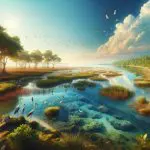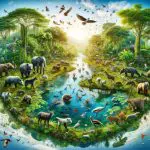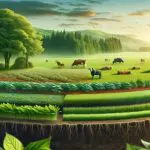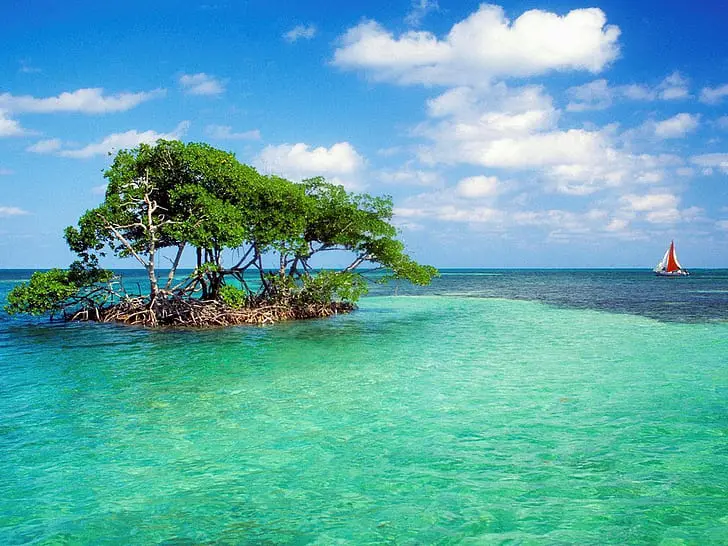
Dive into the world of mangroves and seagrass! Discover their crucial role in our ecosystem and efforts to protect these vital habitats.
Mangroves and Seagrass Key Takeaways:
- Mangroves and seagrass are key ecosystems in coastal environments.
- Mangroves, with their dense roots, protect coastlines and support diverse wildlife.
- Seagrass meadows act as carbon sinks and nurture marine life.
- Both play a vital role in mitigating climate change and sustaining marine biodiversity.
Welcome to the fascinating world of mangroves and seagrass!
These natural wonders are not just beautiful; they are vital to our planet’s health.
In this journey, we’ll explore how these ecosystems sustain marine life, protect our coastlines, and fight against climate change.
Let’s uncover the hidden stories of mangroves and seagrass!
Introduction: The Hidden Power of Mangroves and Seagrass

Mangroves and seagrass are nature’s unspoken guardians, playing a vital role in our ecosystem.
These unique habitats, often overshadowed by more prominent natural wonders, are crucial in the fight against climate change.
Mangroves, with their tangled roots, thrive along coastlines, offering a natural barrier against extreme weather.
Seagrass meadows, the underwater equivalent, create a haven for diverse marine life.
Both are exceptional in capturing and storing carbon, a key factor in controlling global warming.
As we delve deeper, we’ll discover the incredible ways these ecosystems contribute to our planet’s health and our fight against climate change.
What are Mangroves and Seagrass?
• Mangroves and seagrass are vital yet often overlooked ecosystems. • Found in coastal areas, mangroves are known for their dense, tangled roots, while seagrass meadows flourish under the sea.
• These habitats are unique, providing a home for a diverse range of marine life.
A mangrove is a shrub or tree that grows mainly in coastal saline or brackish water. Mangroves grow in an equatorial climate, typically along coastlines and tidal rivers. They have special adaptations to take in extra oxygen and to remove salt, which allow them to tolerate conditions that would kill most plants. Wikipedia
Their Role in Climate Change
These ecosystems are not just natural wonders; they are critical in the fight against climate change.
- Mangroves and seagrass excel at capturing and storing carbon dioxide, a major greenhouse gas.
- By doing so, they play a significant role in controlling global warming.
The Importance of Preservation
Preserving mangroves and seagrass is crucial for maintaining the balance of our planet’s ecosystem.
In the following sections, we’ll explore the unique characteristics of these habitats and their importance in our global environmental health.
Understanding Mangroves
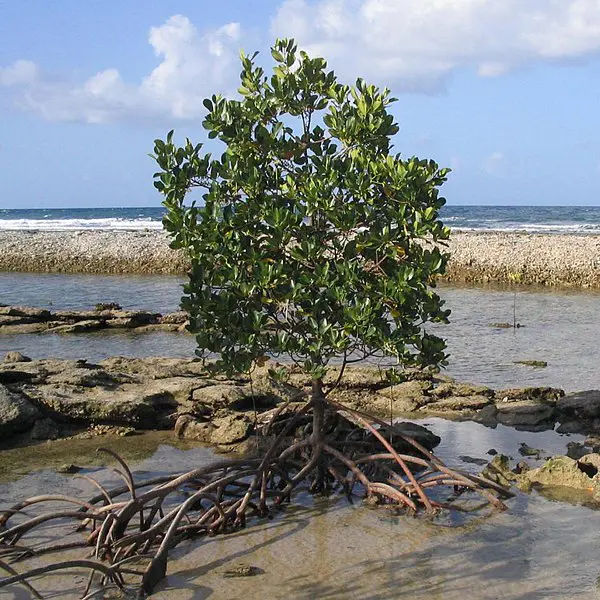
Mangroves, the coastal sentinels, are ecosystems with remarkable abilities.
These trees, uniquely adapted to saltwater environments, are found along shorelines worldwide.
In this section, we’ll explore what mangroves are, their distinct characteristics, and the diverse species that form these vital coastal guardians.
Defining Mangroves
Mangroves are more than just trees; they are an entire ecosystem. These unique plants grow in coastal saline or brackish water.
What sets them apart is their dense, tangled root systems, which are visible above the water.
This intricate root network not only supports the tree but also provides a haven for marine life.
Characteristics of Mangroves
Mangroves are recognized for their ability to thrive in challenging environments where other plants would struggle.
They can withstand high salt levels, extreme tides, and muddy, oxygen-poor soil.
These trees have adapted to such conditions with special roots, called pneumatophores, which stick out of the water and help them ‘breathe’.
Global Distribution
Mangroves are not confined to one part of the world; they have a global presence.
They flourish along the coastlines of over 123 countries, mainly in tropical and subtropical regions.
The largest mangrove forests are found in countries like Indonesia, Australia, and Brazil, but they are a common feature in many coastal regions.
Varieties of Mangrove Species
There’s an incredible variety of mangrove species, with more than 60 different types identified.
Each species has adapted uniquely to its environment. Some are short shrubs, while others grow into tall trees.
Their adaptability makes them a critical part of the coastal ecosystem, acting as a natural barrier against erosion and extreme weather.
Table 1: Key Characteristics of Mangroves
| Characteristic | Description |
|---|---|
| Habitat | Coastal areas in tropical and subtropical regions |
| Root System | Dense, tangled roots that are visible above water |
| Adaptation | Special roots for surviving in saltwater and low-oxygen soil |
| Biodiversity | Supports a range of species including fish, birds, and crustaceans |
| Climate Impact | Effective carbon sinks, reducing atmospheric CO2 |
In A Nutshell:
Mangroves are not just trees; they’re a critical part of our planet’s coastal ecosystem.
Their unique adaptations make them essential for both marine life and human communities.
In the next sections, we’ll dive deeper into their role in climate change and how they benefit local communities.
Mangroves and Climate Change

The Carbon-Capturing Power of Mangroves
Mangroves are not just coastal protectors; they are also silent warriors against climate change.
Their unique ability to capture and store carbon dioxide is remarkable.
This process, known as carbon sequestration, involves mangroves absorbing CO2 from the atmosphere and storing it in their biomass and the surrounding soil.
The dense, organic-rich mud found in mangrove forests traps a significant amount of carbon, preventing its release back into the atmosphere.
This makes mangroves one of the most efficient natural carbon sinks on our planet.
Mangroves: A Natural Barrier Against Extreme Weather
Aside from their role in carbon storage, mangroves offer crucial protection against extreme weather events.
Their dense root systems act as a natural barrier, reducing the impact of storm surges and high winds.
During hurricanes and cyclones, these roots can dissipate wave energy and help to protect coastal areas from erosion.
This not only safeguards the environment but also plays a vital role in protecting coastal communities from the devastating effects of such natural disasters.
In A Nutshell:
Mangroves’ dual role as both carbon sinks and natural storm barriers highlights their importance in our fight against climate change and in protecting coastal habitats.
Their preservation and restoration are key to mitigating the impacts of global warming and safeguarding our coastlines.
Mangroves and Community Benefits
Supporting Local Livelihoods
Mangroves are not just environmental assets; they are also economic powerhouses for many coastal communities.
These ecosystems provide an array of livelihood opportunities. For instance, mangroves are crucial for fisheries, as they serve as breeding and nursery grounds for numerous fish species.
This enhances local fishing industries, providing a stable food source and income for fishermen.
Additionally, mangroves are ideal for beekeeping, where their flowers offer a rich source of nectar.
This not only supports biodiversity but also provides local communities with a sustainable livelihood through honey production.
Mangroves and Ecotourism
Another significant aspect of mangroves is their contribution to ecotourism.
The unique beauty and biodiversity of mangrove ecosystems attract tourists, creating opportunities for local communities to develop eco-friendly tourism initiatives.
These can include guided boat tours, bird watching, and educational walks, offering visitors a chance to explore and learn about these vital ecosystems.
This not only provides economic benefits but also raises awareness about the importance of mangrove conservation.
Biodiversity Hotspots
Mangroves are hotspots of biodiversity. They are home to a myriad of species, from fish and crustaceans to birds and mammals.
Specifically, they are crucial for juvenile marine life. Many fish species, including commercially important ones, use mangroves as nurseries.
The roots provide shelter and a rich feeding ground for these young creatures, ensuring a healthy start to their life.
This biodiversity is not only important for ecological balance but also supports the food chains that sustain local communities.
In A Nutshell:
In conclusion, mangroves are essential for both the environment and the communities that depend on them.
Their role in supporting livelihoods, promoting ecotourism, and nurturing biodiversity underscores the need for their protection and sustainable management.
Exploring Seagrass
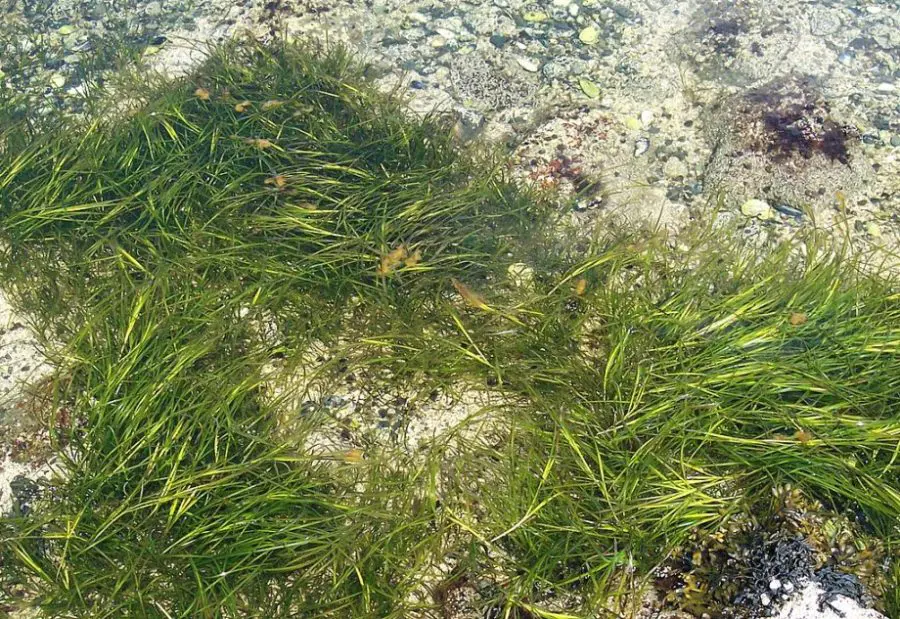
Seagrass meadows, often unseen beneath the ocean’s surface, are vital to our marine ecosystems.
These unique underwater plants provide essential habitats, support biodiversity, and play a critical role in carbon sequestration.
This section delves into what seagrass is, its ecological importance, and the concerning global decline of these meadows.
Not to be confused with seaweed, plant-like algae, or with beachgrass, a terrestrial plant
Seagrasses are the only flowering plants which grow in marine environments. There are about 60 species of fully marine seagrasses which belong to four families (Posidoniaceae, Zosteraceae, Hydrocharitaceae and Cymodoceaceae), all in the order Alismatales (in the clade of monocotyledons). Seagrasses evolved from terrestrial plants which recolonised the ocean 70 to 100 million years ago. Wikipedia
Defining Seagrass
Seagrass meadows are among the most productive ecosystems on our planet, yet they remain relatively unknown to many.
Seagrass is not a type of seaweed but rather a group of flowering plants that have adapted to live fully submerged in saltwater.
These underwater meadows are found in shallow, sheltered coastal waters around the world.
They play a vital role in the marine environment, acting as nurseries for young fish and invertebrates, filtering sediments from the water, and stabilizing the seabed.
The Ecological Importance of Seagrass
The ecological significance of seagrass cannot be overstated.
They are incredibly efficient at absorbing and storing carbon dioxide from the atmosphere, much more so than terrestrial forests.
This makes them a key player in mitigating climate change.
Additionally, seagrass beds are essential breeding and developmental grounds for many marine species, contributing significantly to the biodiversity and productivity of coastal ecosystems.
The Global Decline of Seagrass Meadows
Alarmingly, seagrass meadows are disappearing at a rapid rate globally.
Pollution, coastal development, and destructive fishing practices are among the leading causes of this decline.
This loss has profound implications, not just for marine life that depend on these habitats but also for the global fight against climate change.
As seagrass beds diminish, their capacity to act as carbon sinks and protectors of marine biodiversity is greatly reduced.
Implications of Seagrass Decline
The decline of seagrass meadows has far-reaching consequences.
It leads to a decrease in fish populations, affecting the livelihoods of millions of people who depend on fishing.
Additionally, the reduction in carbon sequestration capacity contributes to the acceleration of global warming.
The loss of these ecosystems also means a decline in their ability to filter pollutants from the water, leading to poorer water quality.
Table 2: Key Characteristics of Seagrass
| Characteristic | Description |
|---|---|
| Habitat | Shallow, sheltered coastal waters worldwide |
| Plant Type | Flowering plants adapted to live fully submerged in saltwater |
| Ecological Role | Nurseries for marine life, water filtration, sediment stabilization |
| Carbon Storage | Efficient at absorbing and storing carbon dioxide |
| Threats | Pollution, coastal development, destructive fishing practices |
In A Nutshell:
Understanding the value of seagrass and the threats it faces is crucial for marine conservation efforts.
The next sections will delve deeper into the role of seagrass in carbon sequestration and the ongoing efforts to restore these vital ecosystems.
Seagrass and Carbon Sequestration
Seagrass meadows are unsung heroes in the fight against climate change, playing a critical role in carbon sequestration.
Their ability to capture and store carbon surpasses many terrestrial ecosystems.
This section explores the efficiency of seagrass in carbon capture and the implications of their loss on global carbon storage.
The Role of Seagrass in Carbon Capture
Seagrass, through photosynthesis, effectively absorbs carbon dioxide from the water, trapping it within its leaves, stems, and sediment.
This process is a natural way of reducing the carbon in our atmosphere, crucial for mitigating the effects of climate change.
Efficiency Compared to Other Ecosystems
When it comes to carbon sequestration, seagrass meadows are more efficient than many terrestrial forests.
They can store significant amounts of carbon in their dense underwater sediments, making them vital carbon sinks.
Impact of Seagrass Loss on Carbon Storage
The decline of seagrass meadows globally poses a significant threat to their carbon storage capacity.
The loss of these ecosystems not only disrupts marine biodiversity but also reduces the earth’s ability to naturally sequester carbon, exacerbating the effects of climate change.
Seagrass Restoration Efforts
Seagrass meadows, crucial for marine ecosystems, are being restored worldwide through various efforts.
This section examines initiatives like Seagrass Ocean Rescue, their objectives, community involvement, and restoration techniques.
Seagrass Ocean Rescue and Its Aims
- Seagrass Ocean Rescue: An initiative led by WWF to restore seagrass habitats.
- Goals: The project aims to plant and nurture seagrass over large areas, revitalizing these vital ecosystems.
- Long-term Impact: The project seeks to demonstrate how restored seagrass meadows can benefit marine life, carbon sequestration, and coastal protection.
Community Involvement in Seagrass Restoration
- Local Engagement: Communities play a pivotal role in the success of these projects, from planting seagrass seeds to monitoring their growth.
- Educational Aspect: Such projects also educate the public about the importance of seagrass and how to protect these delicate ecosystems.
- Collaboration: Partnerships with local organizations, schools, and volunteers are essential for the widespread restoration of seagrass meadows.
Techniques Used in Seagrass Restoration
- Seed Collection and Sowing: Collecting seeds from healthy meadows and sowing them in degraded areas.
- Mechanized Planting: Developing tools and methods for efficient planting and coverage of larger areas.
- Monitoring and Maintenance: Regular assessment of the health and growth of planted seagrass to ensure successful restoration.
In A Nutshell:
Through initiatives like Seagrass Ocean Rescue, there is a growing recognition of the importance of restoring seagrass meadows.
These efforts not only revive marine biodiversity but also contribute to climate change mitigation and coastal protection, making them integral to marine conservation strategies.
The Symbiotic Relationship
The relationship between mangroves and seagrass ecosystems is a classic example of nature’s interconnectedness.
This section explores their symbiotic relationship and how the conservation of one habitat positively impacts the other.
Interdependency of Mangroves and Seagrass Ecosystems
- Nutrient Cycling: Mangroves and seagrass often exist in close proximity, contributing to a shared nutrient cycle. The detritus from mangroves provides essential nutrients for seagrass, which in turn supports a variety of marine life.
- Habitat Linkage: These ecosystems provide critical habitats for many species during different life stages. For instance, many fish species use seagrass meadows as nurseries and mangroves for adult shelter.
- Water Quality Improvement: Both mangroves and seagrass help to filter and purify water, enhancing the overall quality of the marine environment in which they coexist.
Mutual Benefits of Protection
- Coastal Protection: Protecting mangroves helps in stabilizing shorelines, which in turn preserves seagrass meadows by reducing erosion and sedimentation.
- Biodiversity Support: Conservation of one ecosystem leads to a healthier, more diverse marine environment, benefiting both mangroves and seagrass habitats.
- Climate Change Mitigation: Efforts to conserve and restore either of these ecosystems contribute to carbon sequestration, helping to combat global warming.
In A Nutshell:
Understanding the symbiotic relationship between mangroves and seagrass underlines the importance of an integrated approach to their conservation.
Protecting and restoring these ecosystems not only sustains their intrinsic ecological functions but also enhances their collective benefits to the environment and human communities.
Conservation Challenges and Efforts
The conservation of mangroves and seagrass faces several challenges, exacerbated by human activities and climate change.
This section addresses these threats and highlights various global and local initiatives aimed at preserving and restoring these vital ecosystems.
Main Threats to Mangroves and Seagrass
- Pollution: Both ecosystems are highly sensitive to pollution, including agricultural runoff, oil spills, and plastic waste, which can devastate these habitats.
- Climate Change: Rising sea levels, increased temperatures, and changing weather patterns pose significant threats to the health and survival of mangroves and seagrass.
- Coastal Development: Unregulated coastal development leads to habitat loss for both mangroves and seagrass. This includes activities like dredging, land reclamation, and construction.
- Destructive Fishing Practices: Methods like trawling and the use of harmful fishing gear can damage seagrass beds and mangrove roots, disrupting these ecosystems.
Global and Local Conservation Initiatives
- Protected Areas: Establishing Marine Protected Areas (MPAs) to safeguard critical mangrove and seagrass habitats.
- Restoration Projects: Initiatives like the Mangroves for the Future program and the Seagrass Ocean Rescue aim to restore degraded ecosystems.
- Community Involvement: Engaging local communities in conservation efforts through education, sustainable livelihood programs, and participatory management.
- Policy and Legislation: Implementing and enforcing laws and regulations that protect these ecosystems from harmful activities and promote sustainable use.
- Research and Monitoring: Conducting scientific research to better understand these ecosystems and monitoring their health to inform conservation strategies.
Table 3: Conservation Efforts and Challenges
| Ecosystem | Conservation Efforts | Challenges |
|---|---|---|
| Mangroves | Protected Areas, Restoration Projects, Community Involvement | Pollution, Climate Change, Coastal Development |
| Seagrass | Seagrass Ocean Rescue, Scientific Research, Policy and Legislation | Climate Change, Pollution, Habitat Loss |
In A Nutshell:
The conservation of mangroves and seagrass is a complex challenge requiring a multifaceted approach.
By addressing the threats they face and implementing effective conservation strategies, we can ensure the survival of these critical ecosystems for future generations.
Mangroves and Seagrass FAQs
In this section, we answer frequently asked questions about mangroves and seagrass, shedding light on their importance, challenges, and conservation.
Q: What are the main benefits of mangroves?
A: Mangroves provide numerous benefits, including:
- Carbon Storage: They capture and store significant amounts of carbon dioxide, helping mitigate climate change.
- Coastal Protection: Mangroves buffer coastlines against storm surges and erosion.
- Biodiversity: They offer vital habitats for a diverse range of species, including fish and bird populations.
Q: Why is seagrass important for the environment?
A: Seagrass is important because:
- Carbon Sequestration: Like mangroves, seagrass meadows are efficient carbon sinks.
- Marine Habitat: They provide nursery grounds for many marine species.
- Water Quality: Seagrass filters and purifies water, enhancing overall marine health.
Q: What are the primary threats to mangroves and seagrass?
A: The primary threats include:
- Pollution: Runoff, oil spills, and plastic waste significantly harm these ecosystems.
- Climate Change: Rising sea levels and temperature changes pose severe risks.
- Destructive Human Activities: Coastal development and harmful fishing practices lead to habitat destruction.
Q: How can we help protect and restore mangroves and seagrass?
A: Ways to help include:
- Supporting Conservation Projects: Engaging with and funding initiatives focused on restoration and protection.
- Sustainable Practices: Adopting eco-friendly habits and supporting sustainable fisheries.
- Raising Awareness: Educating others about the importance of these ecosystems and advocating for protective policies.
Q: Are there any successful examples of mangrove and seagrass restoration?
A: Yes, successful examples include:
- Mangroves for the Future: A program focusing on sustainable management and conservation of mangroves in Asia.
- Seagrass Ocean Rescue: The largest seagrass restoration project in the UK, aiming to restore seagrass habitats.
Q: Can individual actions make a difference in protecting these ecosystems?
A: Absolutely, individual actions can make a significant impact. This includes:
- Reducing Pollution: Properly disposing of waste and reducing plastic use.
- Supporting Responsible Tourism: Choosing eco-friendly tourism options that respect natural habitats.
- Advocacy and Education: Spreading the word about the importance of these ecosystems and advocating for their protection.
These FAQs aim to enhance understanding and encourage actions towards the preservation of mangroves and seagrass.
Each contribution, no matter how small, can lead to a positive change in conserving these vital ecosystems.
Conclusion: The Vital Role of Mangroves and Seagrass in Our Ecosystem
As we wrap up our exploration of mangroves and seagrass, it’s clear that these ecosystems are not just beautiful natural landscapes, but vital components of our planet’s health.
In this conclusion, we’ll emphasize their indispensable roles in combating climate change, supporting marine biodiversity, and safeguarding coastal communities, underscoring why their preservation is essential for a sustainable future.
Fighting Climate Change and Supporting Marine Life
Mangroves and seagrass play a pivotal role in the health of our planet.
These ecosystems are crucial in fighting climate change through their exceptional carbon sequestration capabilities.
Additionally, they support a vast array of marine life and protect coastal communities from extreme weather events.
Learn more about blue infrastructure.
Beyond Environmental Importance
The conservation of mangroves and seagrass is more than an environmental issue.
It’s a necessity for maintaining the balance of our ecosystems and the well-being of countless species, including humans.
The decline of these habitats due to pollution, climate change, and destructive human activities is a pressing concern that requires immediate and sustained action.
A Combined Effort for Conservation
To safeguard these invaluable ecosystems, a combined effort from individuals, communities, governments, and international organizations is essential.
This includes supporting conservation projects, adopting sustainable practices, and raising awareness about the importance of mangroves and seagrass.
Conclusion: Towards a Sustainable and Resilient Future
In conclusion, the preservation and restoration of mangroves and seagrass are critical in our journey toward a more sustainable and resilient future.
By recognizing their value and working toward their protection, we can ensure that these vital ecosystems continue to thrive for generations to come.
Additional Resources
For those interested in diving deeper into the world of mangroves and seagrass, the following links provide valuable information and insights:
- World Wildlife Fund (WWF) – Mangroves: WWF Mangroves Learn more about mangroves, their ecological importance, and WWF’s efforts in mangrove conservation.
- Seagrass Ocean Rescue by WWF-UK: Seagrass Ocean Rescue Discover the largest seagrass restoration project in the UK, aiming to restore these crucial underwater meadows.
- United Nations Environment Programme (UNEP) – Seagrasses: UNEP Seagrasses Explore the role of seagrasses in the ecosystem and the challenges they face.
- The Nature Conservancy – Protecting Mangroves and Seagrasses: The Nature Conservancy A perspective on the importance of protecting mangroves and seagrasses for our climate future.
- Global Mangrove Alliance: Global Mangrove Alliance An organization focused on increasing mangrove habitats by 20% by 2030 for climate change mitigation and adaptation.
These resources offer comprehensive information about the importance, challenges, and conservation efforts related to mangroves and seagrass, providing a deeper understanding of their role in our global ecosystem.

